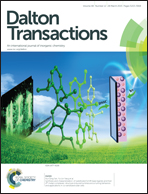A new visible-light-excitable ICT-CHEF-mediated fluorescence ‘turn-on’ probe for the selective detection of Cd2+ in a mixed aqueous system with live-cell imaging†
Abstract
A new quinoline based sensor was developed and applied for the selective detection of Cd2+ both in vitro and in vivo. The designed probe displays a straightforward approach for the selective detection of Cd2+ with a prominent fluorescence enhancement along with a large red shift (∼38 nm), which may be because of the CHEF (chelation-enhanced fluorescence) and ICT (internal charge transfer) processes after interaction with Cd2+. The interference from other biologically important competing metal ions, particularly Zn2+, has not been observed. The visible-light excitability of the probe merits in the viewpoint of its biological application. The probe enables the detection of intracellular Cd2+ with non-cytotoxic effects, which was demonstrated with the live RAW cells. The experimentally observed change in the structure and electronic properties of the sensor after the addition of Cd2+ were modelled by the density functional theory (DFT) and time-dependent density functional theory (TDDFT) computational calculations, respectively. Moreover, the test strip experiment with this sensor exhibits both absorption and fluorescence color changes when exposed to Cd2+ in a mixed aqueous solution, which also makes the probe more useful. The minimum limit of detection of Cd2+ by the probe was in the range of 9.9 × 10−8 M level.


 Please wait while we load your content...
Please wait while we load your content...